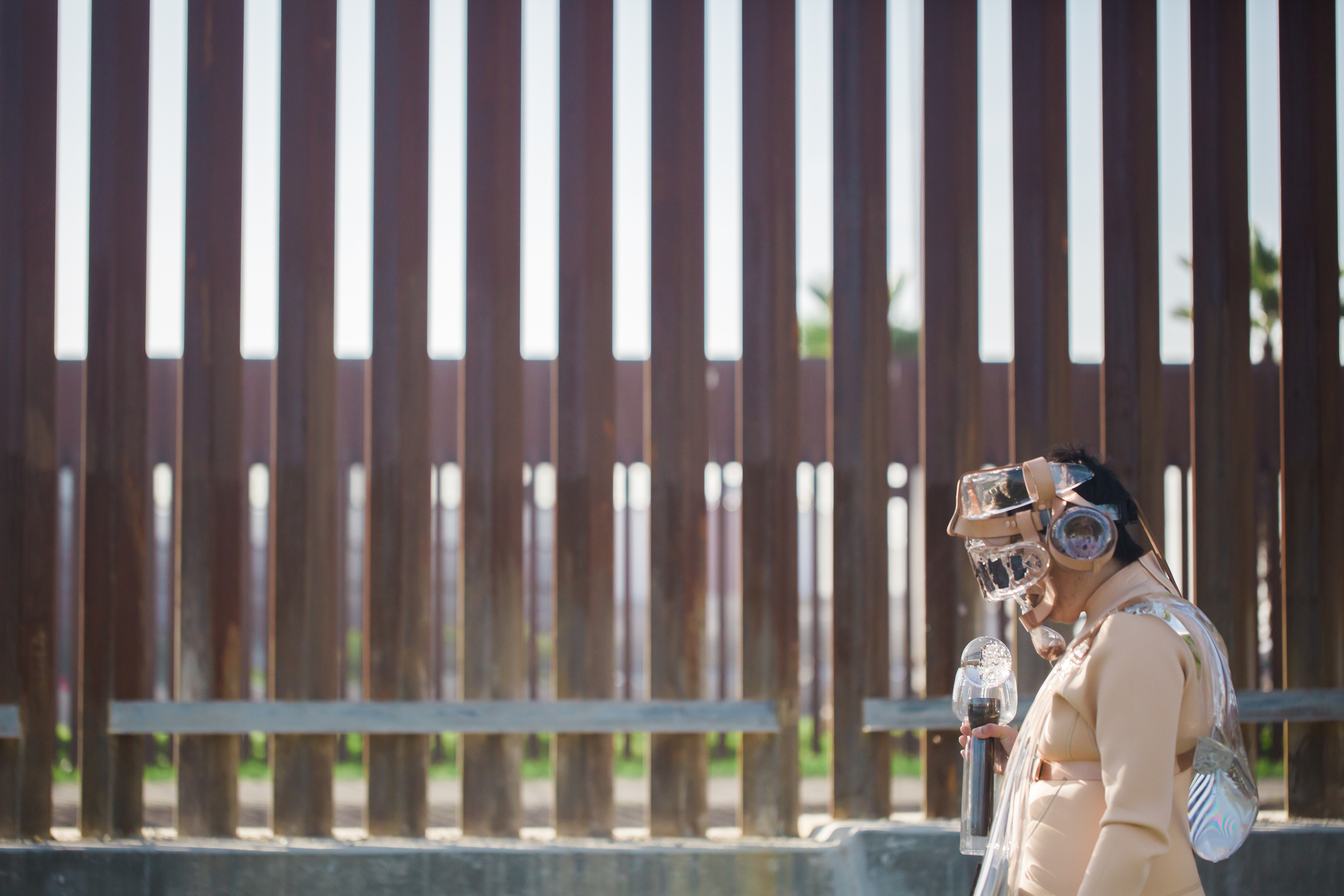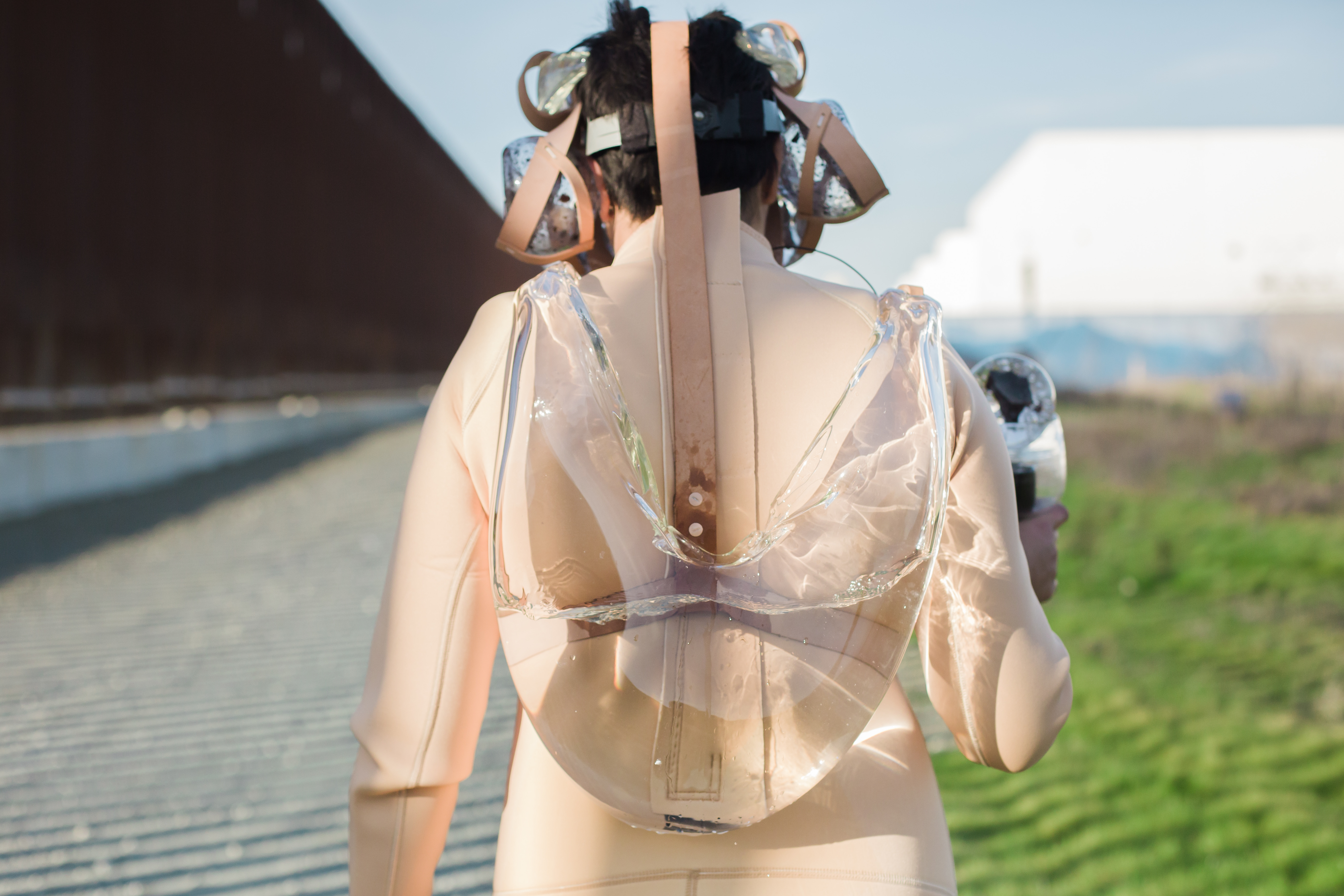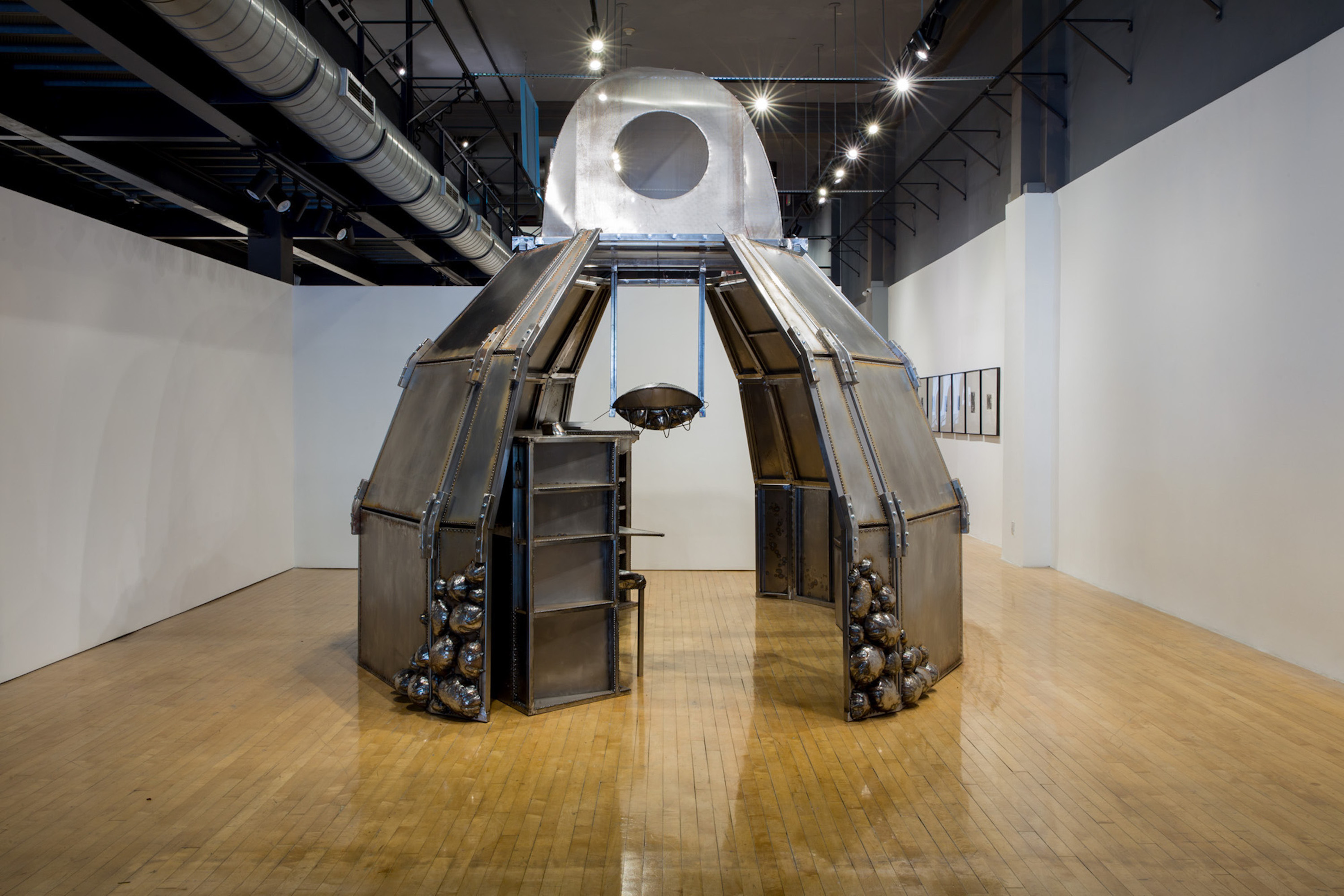Issue 18: Of Passageways and Portals - Borderlands Mexico USA
Daniela Lieja Quintanar, Claudia Pretelin
Reading time: 13 minutes

23.07.2020
Based on the curatorial research Intergalactix: against isolation/contra el aislamiento, curators Daniela Lieja Quintanar and Claudia Pretelin, associate researcher and exhibition advisor, discuss how the curatorial process can become a collective tissue that responds to the urgencies of the present, particularly in light of migration policies and the histories that intersect there.

The possibility of imagining a pluralistic future becomes pertinent when we come face-to-face with a present that reinforces borders in order to mark differences and distances. Daniela Lieja Quintanar’s curatorial research Intergalactix: against isolation/contra el aislamiento, to be presented next year at Los Angeles Contemporary Exhibitions (LACE), stems from this wager for a different future. From Hollywood to Boyle Heights in California, this conversation also positions itself as a strategy for resistance against the physical and conceptual borders that the present administration’s politics continue to generate during times of isolation.
Claudia Pretelin: How did Intergalactix: against isolation/contra el aislamiento come to be, and in what context is it located in?
Daniela Lieja Quintanar: This curatorial research formalized when I submitted a proposal to the Andy Warhol Foundation’s Curatorial Fellowship in the fall of 2018, which was then awarded to me in 2019. It began as a two-year project, but now I consider it a long-term research, if not lifelong. After six years of living in the United States, and specifically Los Angeles, my perception of borders and migration has changed radically. My own migratory experience is one of coming and going, of traveling through air and land, of the oft-cited neither from here nor there effect, of the process of being integrated into multiple communities, of parallel, mixed, and remastered languages, of shared language, of my chilango accent that becomes Puerto Riquan, Colombian, TIjuanan, and who knows what else. To be literally classified as an Alien, the department of Homeland Security, ICE (La Migra), Central America in Los Angeles, Tijuana, and all sort of labels. Sometimes I’m brown, light skin, other times Latina, Latinx, Mexican. My own hardships and privileges, discrimination: a pluriverse complex, a space of contradiction.
On November 8, 2016, I witnessed the results of the elections at a pool hall in Boyle Heights, a Mexican neighborhood in East LA. It was a dark, devastating, revealing, and depressing day. But I wouldn’t have received the terrible news in any other place! A cantina that served as a portal to a Mexico and a time that no longer exists. I remember clearly a vintage, black-and-white poster of Emiliano Zapata with the phrase: “I would prefer to die standing up than to live on my knees.” This neighborhood, in ancestral times, was called Apachianga; it was the homeland of the Tongya people, an indigenous community that continues to resist its culture’s erasure. This neighborhood, and its deep migrant history, embraced me, becoming my home and taught me about community organizing, resistance, and struggle.
When Trump won the elections, groups such as Unión de Vecinos[1] in BH reminded us that the struggle against racism and the white supremacist system was nothing new and that this president would not intimidate them. The desire to continue working collectively and to honor these historic struggles was reinforced in many other Central American and Latinx organizations.

CP: Under what premise can Intergalactix generate knowledge and elucidate understanding of the recent past and the ongoing violence generated from specific encounters between north and south which continue to impact the present? For example, you speak of migrant organizations and community networks.
DLQ: Intergalactix departs from the premise of tracing histories of resistance to confront our present and future. The investigation attempts to bring to light, trace, delve into, and sometimes simply remember some of the many historical resistances that have grown from artistic and social experience in order to attack colonial border & immigration politics.
During this time, I have been grouping genealogies of collaborative practices in which art merges with the social and political aspects of migratory contexts. The genealogies sometimes take the shape of interviews, conversations, workshops, lectures, and concept maps. The latter is my favorite visual and conceptual exercise—it helps us visualize how to construct our own genealogies. These genealogies can arise through either a collective or a personal, retrospective process. And, in that sense, we generate an archive open for research, but above all, open for connection and the establishment of relationships of exchange.
The investigation has been located and relocated within various regions in Central America. Specifically, Guatemala, El Salvador, and Honduras—as they have great influence in Los Angeles, San Diego, Tijuana, Mexicali, El Paso, Ciudad Juárez, and Mexico City. This project erases geographies in order to focus on diasporas, those that (trans)form, move from one place to another and reconfigure themselves through time and space. In this sense, it is of utmost importance to have multiple perspectives, lived experiences that merge and move while creating tensions that misplace singularities, precisely to attack the false notion that Trump’s promised wall exists only at the border between Mexico and the United States.
On August 21, 2018, in a Zapatista communiqué, sub-commandant Moisés said that the wall is not at the Rio Grande, but rather in southern Mexico; precisely where this community of resistance lives autonomously in physical isolation. The text describes southeastern Mexico as part of Central America. This highlights two important points: the wall became visible and increasingly oppressive the second that Mexico decided to accept Trump’s pensions to militarize its southern border and stop migrants.

On the other hand, there are walls within the United States as well. Those detention centers are actually concentration camps where children of all ages, teenagers, and entire families find themselves in violent situations and extreme deprivation, completely isolated. ACLU reports indicate that in 2018, ICE detained around 50,000 migrants daily.[2]
There are Trump’s walls: in the carceral system, one of the United States’ largest economies. Everything is connected through millionaire private companies; the one that is currently building the physical wall at the Rio Grande is the same company that built the wall between Palestine and Israel. Inside the United States, the border is a mere 100 miles, it is almost invisible to the human eye, but surveillance technology covers it all.
The premise is, then, that borders and their walls exist in multiple physical and symbolic spaces. And that is why the perspectives that contribute to this project have to be dispersed, but intergalactically connected. The project’s gaze is inherently diasporic and takes its energy from the heart of the movement: Central America. This region, of which the Zapatistas feel a part of, is a region of indigenous revolutionary legacy and struggle, that continentally connects south and north.
CP: In this sense, curatorship has become an exercise in collectivity instead of unidirectional discourse. Through research—in which we have had the opportunity to collaborate—but also through contacting artists that we showcase. Could you speak about your interest to generate dialogue between countries, origins, and identities that happen to be so different from each other? What has been the process to select the commissioned projects that make up this exhibition?
DLQ: The title of the exhibition is a direct reference to the intergalactic meeting that happened in 1996, convened by the Zapatistas, and took place in their territories. A forum for the defense of humanity and against neoliberalism that was able to bring together organizations and collectives from around the world, a watershed for many struggles that is recognized as the instigator of global movements and the protest known as the Battle of Seattle in 1999. Zapatista discourse has been based on and fed from the creation of a network of resistance, a web of forces, of collective work. The more than 500 years of indigenous resistance have been a great inspiration for my own curatorial practice.
The constant revision of social movements and my own participation in contemporary movements inspires me to generate a methodology of collaboration; as I explained previously, this theme requires multiple voices and perspectives. The misnamed migrant caravans are definitely a collective structure that I respect profoundly. My interests go beyond social movements to include art, artistic practices, and the artists that have created critical work in an intersectional, organic, and collaborative manner to go beyond the work of art as capitalism merchandise.
The true challenge is in curatorial practice itself within the contemporary art world, as it constantly leads you to individual work. That is why I am interested in collaborating with different people. In your own case, for example, you contribute your interest in creating living-memory instruments through your website that centers oral history, doing the incredibly important job of recollecting voices. In the same manner, we have been part of an extensive process of learning and reflecting, parting from our experience as migrants, collective readings and our trip to El Salvador together. That is one of the key points to collaborating with different artists, curators, activists, historians, poets, and theorists: learning and activating the intergalactix.

The selection process has actually been more self-selective, as I toy with leaving behind the traditional curatorship model; that of the erudite connoisseur. Collective collaborations have taken me to establish important working and learning relationships with artists such as Tanya Aguiñiga, Cognate Collective and Beatriz Cortez. They all differ in their creative processes and in their reflective and critical approaches; they have a robust track record and have worked on borders and migration for a long time—parting from their personal and community experiences—and yet they do not limit themselves to these themes. In the same way, I continue the process of collaborating with other artists that take part in this exhibition.
CP: Stemming from your theoretical stance, I am also curious in exploring your interest in perspectives that approach Gloria Anzaldúa’s Chicano feminist queer thought, Achille Mbembe’s postcolonial theories, and indigenous movements as tools to decolonize curatorial practice.
DLQ: I think that it is impossible to analyze today’s migratory phenomenon without studying the various queer feminist Latinx texts that have arisen in the United States. Gloria Anzaldúa’s Borderlands/La frontera: The New Mestiza (1987) is a cornerstone for understanding the world of those that have been historically marked by the border and its imposed nationalist dualities. Her theory is a poetics of political resistance, of spirituality and gender. I am interested in her focus on living without borders and instead inhabit the crossroads. In these crossroads is where I build the intergalactix, alliances, and possibilities for a coalition between different disciplines, groups, and schools of thought.
Sayak Valencia, from Tijuana, has also been foundational, as her work speaks of the transfeminist perspective that underscores transitory states, not only between transgender discourse within feminism, but also in migration, mestizaje, race, class, and how all of these categories are intertwined in the creation of a collective memory of social uprisings. There is a search for roots because as Anzaldúa describes, there is a sensation that we have been uprooted, banished, left without a history, without an identity. That is why I am interested in personal and collective genealogies, not as a scientific quest for a genesis’ past, but as a free and imaginative association of influences and roots that take us through diverse routes that open the possibility for different futures. A search for that which is erased and repressed by colonial systems. The possibility to generate memory from within specters and the imagination.
In the same manner, I am interested in investigating contemporary indigeneous movements, such as the Zapatistas, whose communiqués, political actions, and lifestyles I incorporate in this project. Likewise, I am interested in reviewing communal politics, such as those generated by Gladys Tzul Tzul in Guatemala. For a long time, indigeneous movements have stressed the importance of caring for our waterways—for example, such is the case of Berta Cáceres and the Honduran indigeneous resistance (Consejo Cívico de Organizaciones Populares e Indígenas de Honduras, COPINH), who dedicate themselves to protect rivers and all life forms, even after Cáceres’s violent assasination at the hands of the DESA company. Berta lives![3]

From Mbembe I retrieve his seminal analysis on the new global regime of mobility, that is in charge of policing borders, facilitating crossings for some and rejecting, through racial violence, others. He talks of an omnipresent border that can be found even in our skin, in our subconscious. He urges us to reopen humanity’s archives, invoking pre-colonial Africa, where movement came before space, and the conceptualization of borders served only to facilitate exchange, circulation, and social relationships. Migration and mobility belongs to the ecosystemic logics that we form part of as human beings. This stance interests me because the communities of Africa, a large and diverse continent, have also experienced violence for migrating towards Europe—we are already cognizant of the thousands of cases in the Mediterranean, but we must not forgot that there is a large group of African migrants that embark on a treacherous and incomprehensible journey to reach the United States. On the Mexican side of the border we can see many of them suffering from isolation, aggravated by cultural and linguistic barriers. All of this has served me as a tool for developing a personal critical positioning and decolonize the discourses internalized by contemporary art; for turning my gaze.
CP: What are the advantages and limitations of creating this kind of curatorial, decolonial cosmovision in an institution such as LACE?
DLQ: LACE has been a radical space for bringing together voices and tensions since its founding in 1978. For me, it is an honor to undertake this project in a space with such a legacy of social engagement and radical, political, artistic experimentation. The intergalactix has happened there before, even as it disappears and coalitions form and tear apart. The famous Chicano collective ASCO came to be in LACE; for more than forty years, they have been exploring the queer, the feminist, the racial. Destination L.A., an exhibition of the Border Art Workshop, is a personal touchstone, as well as Ana Mendieta’s first retrospective after her murder, amongst other projects.
LACE is located in front of Hollywood Boulevard, a place that, upon first glance, is banal, white, replete with Scientologists and tourists. A frivolous place where urban development companies devour what is left of local spirit. Lots of queer youth escape their homes to live amongst these contradictory and luminous streets, but there is an intersectional spirit that came back to life some weeks ago with the Black Lives Matter movement. This movement took Hollywood’s streets and fused with the energy that LACE emanates.
CP: Given the recent global health crisis, how have you had to adapt your practice and change this project to continue inspiring resistance against isolation?
DLQ: Isolation has been brutal. In terms of my research, it left us without the experience of traveling to Guatemala to meet and talk with artists and curators that we had planned on visiting. But it has also obligated me to redefine the project around new questions and concerns. Questions about mobility and isolation become more real and less conceptual. I am still unsure of the turn that the exhibition will take. These days have been exhausting, there is a lot of collective work to be done. It is strenuous when there is a virus that attacks everyone equally, but somehow still manages to affect mainly the working class, the Black and Latinx communities, migrants and their families, as well as the families of incarcerated Central Americans. The violent forms of isolation intersect with exacerbated racism; the “concept” of disinfection is terrifying, especially in detention centers, history repeats itself as chemicals are used to “disinfect” and thus enable an annihilation, as they did with braceros. It is devastating, and when we come face-to-face with this, art-making seems absurd, but it is not. That is exactly what they are trying to do, to take away that human value that allows us to create relationships. They want us to be isolated, producing selfishly, and I think in that sense this project has the potential to become a space where we can be together, reflect, learn, share, and build human relationships of struggle and resistance.
Unión de Vecinos is an organization that emerged in the 1990s as a result of actions against the demolition of Pico-Aliso Housing Project belonging to Latino families, they are now part of a larger movement against displacement, gentrification and the fight for the right to housing, which is the Los Angeles Tenants Union, of which Daniela is an active member.
In Plain Sight (#XMAP), a coalition of 80 artists dedicated to the abolition of migrant detention centers, perfectly illustrates the seriousness of these incarceration policies. A very relevant project at the moment organized by the artists Cassils and Rafa Esparza. More information at: https://xmap.us/about
Katia Lara’s documentary Berta Vive illustrates part of Cáceres’ tireless struggle. Available at: https://vimeo.com/229310580
Between 1942 and 1964, the US started a program to use Mexican labor temporarily in their crops. The braceros, as they are known, were subjected to disinfection and humiliation processes with DDT, a chemical that can cause serious damage to health. More information at: http://braceroarchive.org/items/show/143
Comments
There are no coments available.